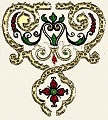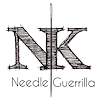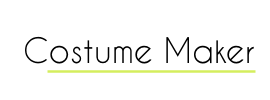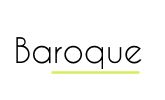 |
Female
Footwear
|
 |
First
half of the 17th century
During this
period men's and women's shoes were the same in style and cut. Therefore,
for a more detailed description, please go to Gentlemen's footwear.
Around 1630,
ladies' shoes were made of fine kid or brocade, often with embroidered
foreparts. Mules, for indoor wear, with curved red heels about 2
inches high had often lace frills around the top line with lace
rosettes at the throat. The toes were square or round.
In 1640 both
the so-called Louis heel with its curved back, and a taller
and slender heel, straight at the back, were worn on brocaded shoes.
In the same fashion as the men's shoes, ribbon rosettes covered
the fastenings at the throat, often ladies didn't were those huge
rosettes because of the length of their skirts.
In 1640-50
ladies' shoes had very shallow square toes, sometimes forked, corresponding
to the shape of the men's shoes. Mules were made of silk or brocade,
shoes of leather, which was often white.

Second
half of the 17th century
In the 1660s
women began taking an interest in their footwear, and no longer
accepted to have the same shape as men's shoes. A variety of exquisitely
embroidered shoes in silk, satin and velvet appeared, trimmed with
lace which fell in a deep flounce over the foot. The forepart became
slimmer and heels rose. The shoes were high and narrow, just like
the Fontange, the hatters was. Thus the base of the figure and its
crowning top were the same.
While men's
shoes were usually made of leather, women's were mainly made of
brocade, satin or embroidered fabric (mostly silk), in white, yellow,
beige, blue, green and violet. Appliquéd braid was widely
used, creating a striped pattern. Most shoes were still decorated
with rosettes made from ribbon, lace or looped leather, but the
sides were already closed. A conspicuous feature of women's shoes
was the white kid edge, used in attaching the sole. It was already
seen in the 1640s and was to continue until the 1760s.
Although frequently
women still wore square toes up to the 1680s, the toe shape started
widely to diverge from the men's. The first points had already appeared
in the 1660s and during the following decades the more elegant point
was adopted. By the 1690s the point was made quite deep, but is
gradually replaced by the needlepoint. The heels were high and usually
curved at the back. A detail like the fancy shaped tongue would
not have been visible under the long skirts, but some had the cupid's
bow regardless, while others had a zigzag top line.
For informal
indoor wear ladies were wearing mules, just like the men. Those
were very often embroidered, there is a beautiful example surviving
made from dark red velvet and embroidered with metal threads.
For protection,
women adopted clogs and pattens. The clog was a small wooden wedge
to fit under the arch of the shoe, covered in strong leather extended
under under the ball and toe, with a socket at the under end to
take the shoe heel. The whole was underlain by a flat sole which
prevented the shoe heel from digging into soft ground. The most
practical version had a leather galosh with latchets to tie over
the shoe, but most women had just a brocade-covered leather latchet,
of the same material to the shoe.
The pattens
were largely the same, with the addition of an iron ring or four-lobed
hoop underneath, to raise the wearer even further. Women continued
to wear boots for riding, and they also adopted for this purpose
a riding habit which copied the male fashion, but of course worn
with skirts.

Female
Costumes
Ladies' Baroque Clothing
Indoor
Garments | Footwear | Accessories | Hairstyles | Head-dresses | Development
of the Fontange
Hairstyles
by Vermeer | Dress
Colours by Vermeer | Head-dresses
by Vermeer
Costume Focus Headwear & Neckwear | Costume
Focus Working Women
Costume
Focus Children's Clothing
Ladies'
Costume Quotes
Male
Costumes
Gentlemen's
Baroque Clothing
Indoor
Garments | Footwear | Accessories | Hairstyles | Head-dresses
Costume
Colours by Vermeer | Hair-
and Head-dresses by Vermeer
Gentlemen's
Costume Quotes
~ ~ ~ ~ ~ ~ ~ ~ ~ ~ ~ ~ ~
Embroidery Gallery | Gallery of Needlework
Engravings
Lace Gallery &
Identification | Glossary
Contents © N. Kipar 1997 |









